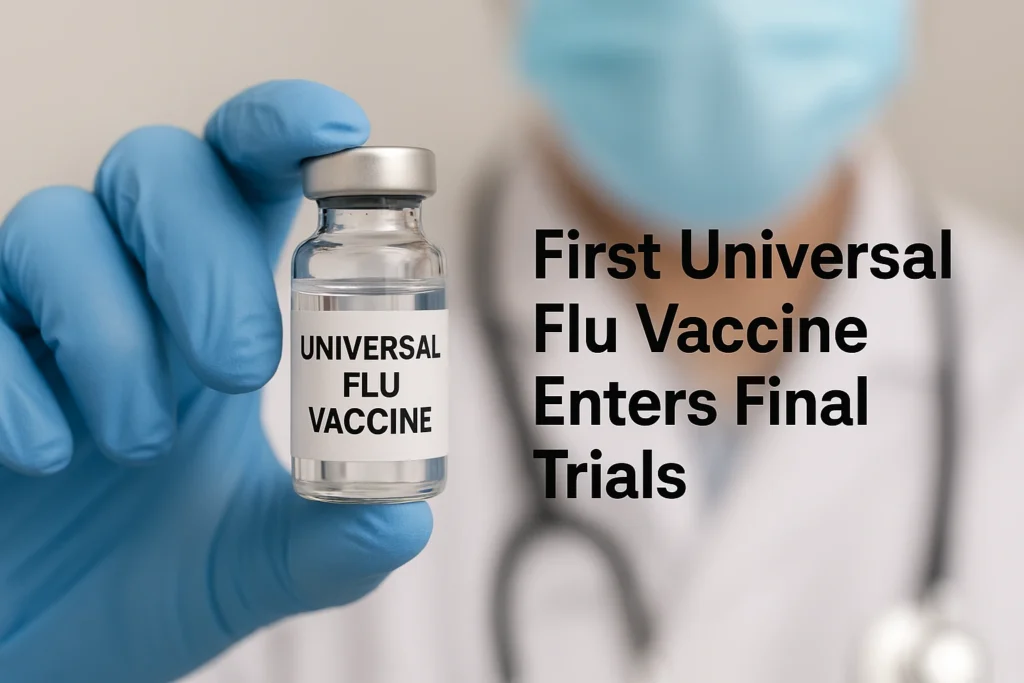For over a century, humanity has engaged in a relentless, yet often frustrating, war against the influenza virus. The ghosts of past pandemics, particularly the catastrophic 1918 Spanish Flu which claimed an estimated 50 million lives globally—more than both World Wars combined—serve as a somber reminder of its destructive potential. Despite a century of unparalleled scientific and medical advancements, influenza has remained one of our most persistent and elusive biological adversaries. Each year, this master of disguise infects up to 1 billion people worldwide, leading to 3 to 5 million cases of severe illness and an estimated 290,000 to 650,000 respiratory deaths, according to data from the World Health Organization (WHO).
The core of this enduring battle has been the virus’s remarkable ability to mutate and evade our immune defenses. Like a cunning criminal constantly changing its appearance, the influenza virus subtly alters its surface proteins each year, rendering our previously acquired immunity—whether from a vaccine or a past infection—ineffective. This constant biological arms race has trapped medical science in a perpetual cycle of reaction. Every year, vaccine manufacturers are forced into a high-stakes guessing game, predicting months in advance which viral strains will dominate the upcoming flu season. Now, after decades of dedicated research and numerous scientific breakthroughs, a solution that could fundamentally change this dynamic is finally within reach. The first universal flu vaccine has entered Phase 3 clinical trials, the final and most crucial stage before potential regulatory approval. This is not just an incremental improvement; it is a paradigm shift, a complete reimagining of our strategy for combating influenza.
The Inherent Limitations of Our Current System
To truly grasp the monumental significance of this breakthrough, one must first understand the fundamental flaws of our current system of annual flu vaccination:
The Prediction Problem and the “Antigenic Drift” Trap
Each February, nearly a full year before the onset of the next flu season, the WHO convenes an expert panel to select the strains for the upcoming vaccine. This critical decision is based on a meticulous analysis of global surveillance data, emerging strain patterns, and historical trends. However, this system is inherently vulnerable to the unpredictable nature of the influenza virus. The virus primarily evolves through two mechanisms:
- Antigenic drift: This involves small, gradual mutations in the viral genes, particularly those encoding the surface proteins. This is a continuous process that forces us to update the vaccine annually.
- Antigenic shift: This is a sudden and dramatic change, typically occurring when a human flu virus and an animal flu virus (such as a bird or pig flu) swap genetic material. This can lead to a novel virus to which the population has no existing immunity, often sparking a pandemic.
These biological gambles mean that our seasonal vaccines are often playing catch-up before they even reach patients, sometimes with significant consequences for public health.
The Effectiveness Rollercoaster: A Game of Chance
The unpredictable nature of these mutations is directly reflected in the wildly fluctuating effectiveness of seasonal vaccines. Data from the Centers for Disease Control and Prevention (CDC) illustrates this inconsistency:
- During the 2014-2015 flu season, the vaccine was estimated to be only 19% effective, a staggering failure that led to widespread illness.
- In contrast, the 2016-2017 season saw a more respectable 40% effectiveness rate.
- Interestingly, the 2020-2021 season, heavily influenced by global COVID-19 precautions like mask-wearing and social distancing, saw vaccine effectiveness climb to an unusually high 50%.
This inconsistency creates significant challenges for public health communication, erodes public trust in vaccination programs, and leaves millions of people inadequately protected each year.
The Manufacturing Lag: A Race Against Time
Even with a perfect prediction, the traditional egg-based vaccine production process is painstakingly slow and takes a minimum of 6 to 8 months. The timeline unfolds as follows:
- The WHO selects the strains in February.
- The chosen vaccine viruses are then grown in fertilized chicken eggs, a process that is both labor-intensive and time-consuming.
- The viruses are harvested, inactivated, and purified to create the final vaccine formulation.
- The final vaccines are then packaged and distributed in the late summer or early fall, just in time for flu season.
This lengthy manufacturing process means we are always fighting last year’s battle, with no ability to adapt to a sudden, last-minute viral change.
The Scientific Ingenuity Behind the Universal Vaccine Revolution
The universal vaccine represents a profound paradigm shift by fundamentally altering which part of the virus our immune system is taught to recognize. Instead of focusing on the constantly changing exterior, the new approach targets the virus’s stable, unchanging core.
The Hemagglutinin Stem Strategy: Targeting the Unchanging Core
Traditional vaccines train the immune system to create antibodies against the “head” of the hemagglutinin (HA) protein, the very part that mutates most frequently. The universal vaccine, in a brilliant act of scientific redirection, focuses instead on the HA stem.
- This region is highly conserved across different influenza strains.
- It changes very little over time, acting as a fixed anchor.
- It is present in nearly all influenza A viruses, the type responsible for the majority of human infections and pandemics.
Early research has demonstrated that antibodies directed against this unchanging stem region can neutralize a multitude of different flu types simultaneously, offering a broad, cross-reactive form of immunity.
Mosaic Nanoparticles: A Master Key for All Flu Variants
Some of the most promising universal vaccine candidates are leveraging cutting-edge nanoparticle technology. These microscopic, self-assembling particles are engineered to:
- Display multiple HA stem fragments from various different flu strains on a single particle.
- Trigger a broader and more powerful immune response by presenting the immune system with a mosaic of potential threats.
- Enhance antibody production in a way that mimics the wider and more robust protection often provided by natural infection, but without the risk of illness.
The mRNA Advantage: Speed, Flexibility, and Precision
Building on the unprecedented success of mRNA technology during the COVID-19 pandemic, several companies are now applying this platform to influenza. mRNA flu vaccines offer a number of key advantages:
- Faster development timelines, potentially reducing the time from strain identification to vaccine production from months to weeks.
- Easier strain updates, allowing for real-time adjustments to emerging threats.
- The potential for combination vaccines, a single shot that could protect against influenza, COVID-19, and other respiratory viruses like RSV, simplifying public health campaigns and improving vaccination rates.
T-Cell Immunity: The Long Game for Long-Lasting Protection
While antibodies are crucial for preventing infection in the first place, other components of our immune system play a vital role. T-cells, in particular, are essential for long-term immune memory.
- T-cells provide longer-lasting protection and are critical for clearing established infections.
- They may offer broader, cross-strain immunity because they can recognize internal viral proteins that are even more conserved than the HA stem.
Some universal vaccine candidates are specifically designed to prime these T-cell defenses, aiming for a robust and enduring form of protection that goes beyond simple antibody production.
Phase 3 Trials: The Final Examination on a Global Stage
The current Phase 3 trials are a vast, meticulously planned undertaking, involving tens of thousands of participants across numerous countries and diverse demographic groups. Researchers are rigorously evaluating several key metrics:
Primary and Secondary Endpoints
- The primary goal is to measure the reduction in confirmed flu cases, the prevention of severe disease, and the decrease in hospitalization rates.
- Secondary measures include the duration of protection, the breadth of the immune response against various strains, and the vaccine’s safety profile across different populations.
Real-World Considerations and Data Collection
The trials are designed to answer critical real-world questions:
- How does the vaccine perform in elderly populations, who are particularly vulnerable to severe flu?
- What is its impact on transmission rates within a community?
- What is its overall cost-effectiveness compared to the current system?
Early data from the trials are promising, with some candidates showing the potential to provide 3 to 5 years of protection and achieve over 75% effectiveness across multiple strains, all while maintaining a strong safety profile.
The Profound Impact on Global Health and Society
If these universal flu vaccines are successful, they will not only change how we fight influenza but will also transform public health and society in ways we are only just beginning to imagine:
Revolutionizing Pandemic Preparedness
A universal vaccine would be the ultimate firewall against the next influenza pandemic. By providing immediate, broad-spectrum protection against a novel strain, it would eliminate the 6-to-8 month vaccine development lag, giving the world a crucial head start to stop outbreaks before they spiral out of control.
Significant Economic Benefits
The economic toll of the flu is staggering. A 2022 study estimated that a universal flu vaccine could:
- Save $3.5 billion annually in the U.S. alone in direct medical costs and lost productivity.
- Prevent over 17 million illnesses and avoid 250,000 hospitalizations each year in the U.S.
Improving Health Equity
A universal vaccine could lead to more consistent protection for vulnerable groups, including the elderly, infants, and those with underlying health conditions. By reducing the need for annual vaccination campaigns, it could also lower logistical barriers and improve immunization rates globally, particularly in developing countries with limited healthcare infrastructure.
Navigating the Final Hurdles on the Path to a Healthier Future
Despite the immense excitement, several significant challenges and uncertainties remain:
Scientific and Durability Questions
- Will the protection from a universal vaccine last for decades, or will boosters be necessary every few years?
- Could the virus eventually evolve a mechanism to evade even these highly conserved targets?
- How will the vaccine-induced immunity interact with natural infections over time?
Implementation and Logistical Hurdles
- Scaling up manufacturing to produce billions of doses globally will be a monumental task.
- Ensuring a robust global cold chain for distribution, particularly for new technologies like mRNA, will be essential.
- Integrating this new vaccine into public health programs worldwide will require careful planning and coordination.
Building and Maintaining Public Trust
The post-COVID era has underscored the fragility of public trust in science and medicine. Overcoming vaccine hesitancy and combating the spread of misinformation will be a continuous effort. Clearly and transparently communicating the complex science and proven benefits of a universal vaccine will be paramount to its success.
The Future of Respiratory Disease Prevention
Looking ahead, the timeline for this medical revolution is rapidly unfolding:
- 2025-2026: We may see the first universal flu vaccines receive regulatory approvals, likely starting in key countries, with initial limited rollouts and continued post-market monitoring.
- 2027-2030: As production scales up, we could see the development of novel combination vaccines—a single shot providing protection against influenza, COVID-19, and RSV—simplifying our seasonal fight against respiratory viruses.
- Long-Term Possibilities: The ultimate goal is a future where a single childhood vaccination could provide a lifetime of protection against influenza, ushering in an era of true pandemic resilience and fundamentally altering our relationship with respiratory viruses.
A Historic Turning Point
The development of the universal flu vaccine represents one of the most significant advances in preventive medicine since the discovery of the polio vaccine. For the first time, we are not just keeping pace with influenza; we are attempting to get ahead of it, to outsmart its evolutionary cunning. As the late Dr. Anthony Fauci often articulated, this is not merely about creating a better flu shot; it is about “redefining our relationship with respiratory viruses altogether.”
The coming years will be a testament to human ingenuity and perseverance. While challenges remain, the scientific progress is undeniable. The age of guessing at flu vaccines may finally be coming to an end, paving the way for a healthier, more secure future for all.



